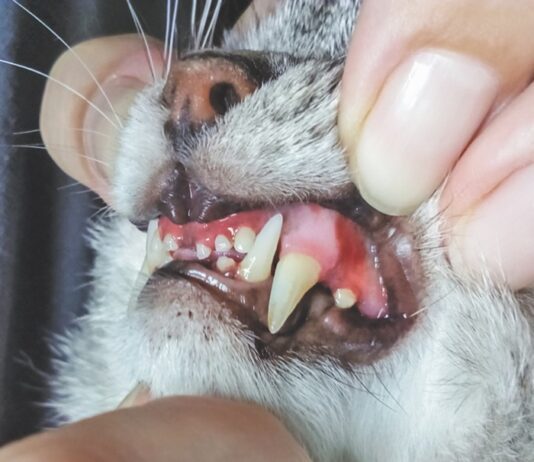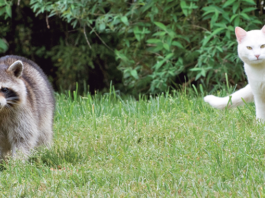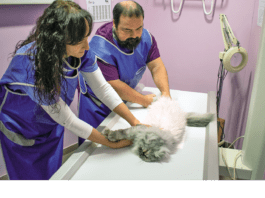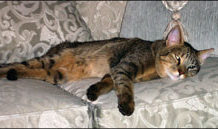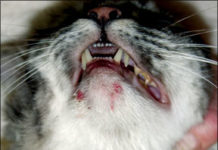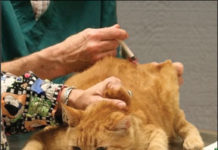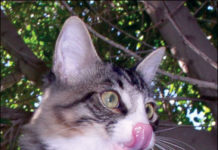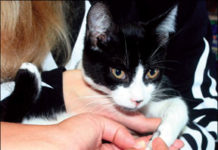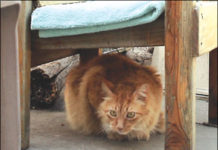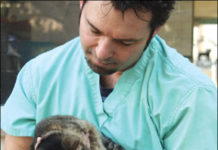Diagnosis: Bladder Stones
Your cat normally uses the litter box a few times a day to relieve herself, but today is different. Shes going to the box every few minutes and vocalizing as she strains to urinate. The small amount of urine that finally dribbles out is filled with blood. Your cat may be suffering from bladder stones, a painful condition that, left untreated, can lead to serious illness and in rare cases, death. Causes of Bladder Stones. Bladder stones, or uroliths, are caused by an extensive concentration of salts and minerals in the urine such as magnesium, phosphorous, calcium, and ammonia. "There should always be a certain amount of salts and minerals in the urine," says Richard Goldstein, DVM, an associate professor of small animal medicine at Cornell Universitys College of Veterinary Medicine. "But when the urine becomes super saturated - meaning theres an overabundance of salts and minerals - crystals begin to form."
Feline Pancreatitis: Serious
Although the feline pancreas is a relatively small internal organ, typically weighing no more than six or eight ounces, it plays a demanding and multifaceted role in maintaining a cats robust health. Indeed, a disease or injury that results in the inflammation of this vital organ - a condition called pancreatitis - could prove fatal unless the animal receives prompt, and potentially quite expensive, medical care. The pancreas is a slender, pink, v-shaped strip of tissue resting snugly within the cats abdomen between its left kidney and its duodenum. It is a glandular organ that performs two life-sustaining functions-endocrine and exocrine. While still in the pancreas, explains Richard Goldstein, DVM, an associate professor of small animal medicine at Cornell Universitys College of Veterinary Medicine, these digestive enzymes are normally sequestered in tiny droplets that prevent their coming into direct contact with pancreatic tissue. Moreover, he says, the enzymes are biologically programmed to remain inactive until after they have been secreted and have traveled via the pancreatic duct into the small intestine.
Hark, Who Goes There?
Quite often, I am told tales of apparently mild-mannered cats that seem to tolerate all of lifes challenges save one: the Trespasser. When face to face with a Cat Errant, Mr. Mellow just cannot cope. We are all cat lovers and certainly wish no harm to our neighbors cats. But naturally, we want to look out for our family. When a resident cat spies a potential intruder, several responses are possible. If you are lucky, your cat might believe that the more, the merrier. He may chirp, he may posture in a beckoning manner, or he may continue to nap calmly, with no apparent interest in the antics of his comrade through the glass. If you are less lucky, you may find that your cat does not trust that the glass is sufficient to keep an offending cat at bay. He may post "Private Property" signs of his own. You may come home to discover that your windows and doors have been marked with urine. If you manage to get through the winter months unscathed, beware the ides of April. For when the windows are opened for a little fresh air, the urgency to reset the barriers will return. The most concerning cat of all is the cat that experiences profound fear upon viewing an unfamiliar cat. The frightened cat may respond by redirecting aggression toward a member of your household. Although other cats are most frequently targeted, other pets and people may find themselves victims of serious attacks. The impact on a relationship can be devastating. Fortunately, you can intervene. You will need to work with both sides of the equation.
Short Takes: 04/09
What once was termed "renal failure" is now called feline chronic kidney disease (CKD), in part because the word "failure" sounded too terminal: Many cats live on for years (with treatment) with chronic kidney disease. One such survivor was the first ShortTakes office manager, the late, great Gertie. That stalwart kitty was diagnosed with renal failure in "middle age," around 11 years old. She hung on to see her 20th birthday - a little shaky toward the end - but mostly thriving with good "quality of life" thanks to expert veterinary care, therapeutic renal diets, blood pressure medicine for her hypertension, and plenty of fresh water for the thirst that goes along with kidney disease.
Acne: All Cats Are at Risk
Despite its typical durability, a cats skin is subject to a wide array of disorders. Most of these conditions, in themselves, are of minor consequence and readily treatable. But all of them merit examination by a veterinarian, since they can signal the presence of a serious infection or other potentially life threatening systemic health problem. Among the various feline skin conditions that might be overlooked - or ignored - by an owner is acne. This disorder, characterized by the emergence of tiny black eruptions (blackheads) on a cats chin and lips, is a condition that can afflict both male and female cats of all ages and breeds. The presence of blackheads usually amounts to nothing more than a cosmetic problem, says William H. Miller, Jr., VMD, a professor of dermatology and medical director of the Companion Animal Hospital at Cornell Universitys College of Veterinary Medicine. However, he points out, feline acne - which appears only on an affected cats face - can evolve into a serious health issue if the benign blackheads turn into pus-filled boils (furuncles) that may signal the presence of a deep-seated bacterial or fungal infection.
When to Vaccinate Your Cat
During the past half-century, no fewer than 10 vaccines have been developed that, according to their manufacturers, can protect your cat against a wide variety of lethal feline diseases. In general, these claims of efficacy have been justified. According to Fred Scott, DVM, PhD, professor emeritus of virology at Cornell Universitys College of Veterinary Medicine and the founding director of the Cornell Feline Health Center, the vaccines have been responsible for "a tremendous improvement in feline health." He cites as a prime example the vaccine created to protect against the feline panleukopenia virus (FPV). "Prior to the late 1960s and early 1970s," says Dr. Scott, "half of all cats that passed through a shelter developed panleukopenia within a few days - and as many as 90 percent of them died from it. Today, the FPV vaccine has totally controlled the disease in properly vaccinated cats. The only time you see it now is in unvaccinated feral or farm cats or those that are in shelters, but that is rare." However, he points out, there are several reasons why owners should refrain from having their cats inoculated annually with every available vaccine. For example, it is remotely possible for a vaccine to damage a developing fetus or stimulate an allergic reaction. And of growing concern is the development of vaccine-associated sarcoma - a type of cancer that, for unknown reasons, emerges at the site on a cats body where a vaccine has been injected. Furthermore, research has brought into question the need for all cats to be routinely revaccinated with all available vaccines every year throughout their lives. Certain laboratory tests may reveal that, as the result of a previous vaccination or natural exposure to an infectious agent, the antibody levels in a cats blood remain high enough to protect it against a specific virus or bacterium. In that case, the animal would be protected against disease associated with that infectious agent and a booster shot would be unnecessary.
Ask Elizabeth: 03/09
My cat, Nickel, meowed at the door to be let in this afternoon, as she always does after her outdoor adventures. Today was different, though, because when I went to the door to let her in she was sitting next to a dead crow. I dont know if she killed the crow, or if she found it dead and brought it for me to admire. Regardless, my first thought was of West Nile Virus. Can you tell me if cats can catch West Nile Virus from crows (dead or alive)? If they can catch the virus, are they able to pass it to humans?
Feline Blood Disorders
The principal function of feline blood, like that of human blood, is to transport oxygen and nutrients throughout a cats body tissues and to carry carbon dioxide and various waste materials away from them. But this is by no means the only vitally necessary role that this rich, red fluid plays. Typically accounting for five percent or so of a cats total body weight, the blood is a key contributor to many other processes, such as cell development, tissue repair and the warding off of infection. The components of a cats blood are virtually identical to those of human blood, notes Marjory Brooks, DVM, associate director of the Comparative Coagulation Laboratory at Cornell Universitys College of Veterinary Medicine. These components include red cells (erythrocytes), which are critical for oxygen delivery and also assist in the removal of toxic carbon dioxide; white cells (leukocytes), which help protect an animal against infection and parasitic disease; platelets, which promote clotting and wound healing; and a colorless fluid (plasma) in which these and other life-supporting blood components - such as hormones, proteins and salts - are suspended. Disorders directly associated with blood abnormalities may not be as easily recognized by owners as other feline diseases. That does not mean that they are necessarily less serious. On the contrary, says Dr. Brooks, the diagnosis of various feline blood disorders - including low platelet counts, low red cell counts, high white cell counts, clotting problems, blood-related cancers and even blood poisonings - are a common occurrence at the Cornell University Hospital for Animals (CUHA). And the diagnosis of one of these disorders - feline anemia - is apt to occur "weekly, at least," she says.
Epilepsy: Always Alarming
Whether happily playing with its favorite toy, vigorously pursuing a tiny mouse, or frantically fleeing from a mean-spirited predator, all of your cats activities rely on the controlled transmission of electrical signals among the billions of nerve cells (neurons) that are jammed into its little brain. In a normal cat, the transmission - or firing - of these signals is well controlled within the central nervous system. These neurons either fire or are inhibited from firing according to an animals shifting needs and desires. In the brains of cats affected with the disorder known as epilepsy, however, this elegant process goes awry. As Alexander de Lahunta, James Law Professor Emeritus of Anatomy at the Cornell Universitys College of Veterinary Medicine, explains: "Neurons are made to fire, so until the transmission of electrical signals is needed, they are kept in a static, inhibited state. If something interferes with that inhibition, an uncontrolled firing of neurons can occur - and that is the phenomenon commonly referred to as a seizure." Dr. de Lahunta describes the "classic" seizure as follows: "The animal suddenly begins to alter its behavior. It acts warily, as if it senses that something unusual is about to happen. It gets very tense, its muscles contract, causing stiffness and trembling. It begins to chew and to drip saliva, even though there is nothing in its mouth. Then the animal becomes increasingly rigid, falls to one side with its limbs extended, and starts paddling them. "Meanwhile, the cats entire body starts shaking - and at this stage, it may stop breathing for as long as 30 or 40 seconds. And then, the panting and shaking and everything else begins to slow down - and within a few minutes, the animal seems to be normal again."
Short Takes: 01/09
When veterinarians ask, "How are things at home?" they probably dont want to hear about your mortgage, your migraines or Aunt Millie in the guestroom. They should be asking about "lifestyle" issues that might be affecting the health of your cat. Problem is, too few vets do, according to a report in the Journal of the American Veterinary Medical Association (JAVMA Vol. 233, No. 10) about client-veterinarian communications. The study compared verbal interactions during well-pet visits - the once-a-year checkups (or twice-yearly visits for older cats) as opposed to vet appointments when a medical problem prompted a visit. Typically, as it turns out, well-pet visits include more verbal interaction with the pets, according to the report: Wellness appointments included "twice as much verbal interaction with the pet as did problem appointments, and the emotional atmosphere of wellness appointments was generally relaxed. There were more social talk, laughter, statements of reassurance and compliments directed toward the client and the pet." In contrast, during problem visits, 90 percent of the talk focused on what the report called "biomedical topics." And that is a problem, the JAVMA report concluded, because "veterinarians may neglect lifestyle and social concerns that could impact patient management and outcomes" when focusing on biomedical issues.
Upper Respiratory Disease
Indications that your cat is experiencing a viral infection of its upper respiratory tract - which includes its nose, sinuses, pharynx and larynx - are similar to those that trouble you when you catch a cold: watery eyes, runny nose, wheezing, sneezing and coughing. Just as you are likely to be completely and permanently rid of your cold within a week or so, a cat, in most instances, will also get over the clinical signs of disease within a few days. In some cases, however, serious complications can occur. About 80 percent of feline upper respiratory infections are caused by either of two viruses: feline herpesvirus (FHV), also known as feline rhinotracheitis virus (FRV); and feline calicivirus (FCV). A third and far less frequent cause of upper respiratory infections in cats is Chlamydophilia felis, a bacterial agent. "All three of these organisms are very specific to cats," says Dr. Richard Goldstein, an associate professor of small animal medicine at Cornell Universitys College of Veterinary Medicine. None of these disease agents, he notes, is transmissible to humans or dogs.
Neurological Disorders
Although its only the size of a golf ball, your cats brain is just about as complex and, when it comes to matters of vital concern, just about as capable as your brain. Of course, a cat uses its brain and the other components of its neurologic system to address needs and desires that are often different from yours. After all, you like to read books and watch movies; your cat likes to torment mice and play with balls of yarn. Sad to say, a cats neurologic system also resembles yours in the wide variety of serious disorders with which it can be afflicted, sometimes with fatal consequences. According to Curtis Dewey, DVM, an associate professor of neurology and neurosurgery at the Cornell University College of Veterinary Medicine, he and his colleagues typically treat four or five neurologically compromised cats each week at the universitys animal hospital.

